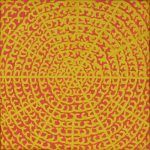Just south of Oxford in Paris, a small stand of trees and knee-high golden grass shield a family cemetery where graves date back to the 1800s. Only a few yards away from the cemetery, artist Theora Hamblett was born in 1895, the daughter of a 72-year-old Civil War veteran and his wife.
She grew up on the family chicken farm, watching the seasons turn and the leaves change. Later, these vistas of rural Mississippi would inspire paintings hanging in American embassies, the Museum of Modern Art and the private galleries of fabulously wealthy men like Nelson A. Rockefeller.
Now, Paris native Harvey Jones guards the hallowed ground where she is interred.

Harvey Jones (Photo by: Cameron Brooks)
Jones said his favorite part of Hamblett’s paintings is the bright colors she used to illustrate the past life of Paris. Bright shades of yellow, orange, blue and purple brighten farm scenes in Hamblett’s distinct primitive style.
“The brushstrokes weren’t the greatest in the world, but it was how the pictures are presented to you,” Jones said. “There are women out there who made great things for the state of Mississippi, and they’re not mentioned as often as the men are. I just wish that more people knew about her and where she came from.”
Jones is disappointed when most people instantly know about William Faulkner, Oxford’s literary icon, or Elvis Presley, Tupelo’s musical legend, but overlook Hamblett’s significance to Southern art.
He once tried to get a portion of Highway 315 named after Hamblett. After all, it was the road she took enroute to her art lessons at Ole Miss.
One day, hopefully soon, Jones still wants to see at least a sign for Theora. But in between overseeing two farms and other daily tasks, he has not had much time to devote toward his cause. He is no relation to Hamblett. Jones said he does not want to make a dime off her memory, but rather wants her to be remembered as a Mississippi Parisian.
“She is part of Mississippi history; she is part of Paris’ history,” Jones said. “The people of Lafayette County should know about it.”
Plainly, it gnaws at him that one of the South’s best primitive artists rests in near anonymity. He thinks the showing of her work at the University Museum is not enough representation in a town where tour buses come from hundreds of miles to tour Rowan Oak.
In a labor of love, Jones keeps the weeds away from all of the headstones and the small chain link fence surrounding it. He says the dates out loud on stone graves as he traces the engraved letters with his finger.
“A graveyard is something to be respected,” Jones said.
Jones bought the property in the 1980s with his father, years after the artist had been buried there.

(Photo by: Cameron Brooks)
Although there is one sign in front of her Van Buren Avenue home in Oxford, Jones said it misleads tourists to think she lived in Oxford her whole life. Jones said even though she began painting seriously in Oxford, she painted scenes from her life in the little red clay hills she called home.
A proud Parisian himself, Jones says, “There’s more to Lafayette County than Oxford.”
Before she lived in the Oxford, Hamblett became a teacher; she taught in a one-room schoolhouse until she left to care for her dying mother in 1931. In 1939, she moved to Oxford about 20 miles away from where she was born. She never married or had any children, and she kept company with very few close friends and family members.
Hamblett rented extra rooms in her home to Ole Miss students and faculty, as well as other locals, during World War II. During that time, not everyone in Paris had a car to drive to Oxford, so people would rent out rooms by the week and work in town.
Paris native Jane Michelleti still remembers meeting Hamblett as a young girl. Michelleti’s sister rented a room from Hamblett once, and said she hardly ever saw Hamblett, despite the fact that only a thin wall separated them.
Pensie Latham, who also knew more of Hamblett than actually knowing her, said she thought Hamblett was often misjudged as a recluse who did not enjoy people.
“You just had to be in her circle,” Latham said.
Many around Hamblett never grasped her impact on the art world, but one saw it right away.
Ed Meek worked for the university’s public relations department in the 1970s when he got to know Hamblett. When he first saw her paintings, he said he fell in love.
Meek said he recognized the importance of her work and wanted to preserve it for Ole Miss. He approached her about helping her promote her work. At first, it was a tough sell, and he moved carefully.
“She was really suspicious of anybody trying to get a painting,” Meek said.
Meek eventually helped her donate 318 original paintings to the University Museum before she died in 1977.
Hamblett gave Meek one of her signature paintings of purple trees one day, but he was disappointed.
“My heart sank to the floor,” Meek said.
He did not like the color because he had never heard of purple trees. Hamblett saw that he was distressed. She then asked him to drive her to Paris. Once there, Meek saw a familiar scene of Mississippi’s seasons in a new light. Seeing was believing.
Meek said he realized he had grown up his entire life without realizing that Mississippi’s sweetgum trees can turn purple, but now he could see it.
“She showed me up in the hills where the purple trees were,” Meek said. “I love that painting because of that story.”
Hamblett was the first artist Meek began collecting.
Anyone can walk into the University of Mississippi Museum and see a small portion of Hamblett’s paintings hanging on the walls. The rest are in storage.
Museum collections manager Marti Funke said Hamblett is among the few Southern self-taught artists who learned in their 50s. There are three major collections of her work: dreams and visions, old home memories and childhood games.
“She had very vivid dreams. There are lots of stories from people around town that knew her personally that she had very strong visions that interrupted her daily life,” Funke said.

(Photo by: Cameron Brooks)
One of her paintings features an angel approaching her as she stands at an ironing board. The spirit is entirely made up of small white and gold flecks from a paintbrush. Funke said the dream paintings are personal and very complicated in many ways.
Hamblett painted for 25 years, and the museum now boasts more than 600 pieces of her paintings, glasswork and drawings.
The first time Jones ever saw the graveyard, it was overgrown. The only thing protecting it from the encroaching woods was a rusty hog wire fence that was falling down.
Now, Jones said he checks on the cemetery often. He walks the path, leaving boot prints in the soft red dirt, as fine as baking flour. The grass is tall and dry around a small headstone that reads, “Gone, but not forgotten,” underneath her name.
“That’s an important person for the state of Mississippi,” Jones said.













